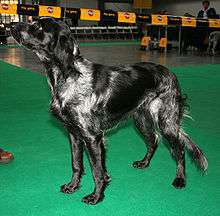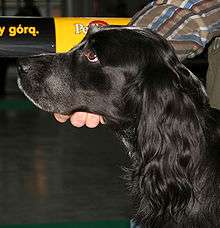Blue Picardy Spaniel
The Blue Picardy Spaniel (or Épagneul Bleu de Picardie) is a breed of Spaniel originating in France, from the area around the mouth of the River Somme, around the start of the 20th century. It is descended from Picardy Spaniels and English Setters, and is described as a quiet breed that requires much exercise due to its stamina. It is especially good with children. Similar to the Picardy Spaniel, it has a distinctive coloured coat. Recognised by only a handful of kennel associations, the breed is predominantly known in France and Canada.
| Blue Picardy Spaniel | |||||||||||||
|---|---|---|---|---|---|---|---|---|---|---|---|---|---|
 A Blue Picardy Spaniel | |||||||||||||
| Other names | Épagneul Bleu de Picardie | ||||||||||||
| Common nicknames | Bleu Picard | ||||||||||||
| Origin | France | ||||||||||||
| |||||||||||||
| Dog (domestic dog) | |||||||||||||
Description
Appearance
A Blue Picardy Spaniel on average is around 22–24 inches (56–61 cm) high at the withers and weighs 43–45 pounds (20–20 kg).[1] Its coat is speckled grey black forming a bluish shade, with some black patches.[2] The coat is flat or a little wavy with feathering on the ears, legs, underside and tail.[3] It has long legs with some setter characteristics.[4]
It has a long broad nose and muzzle, with thick ears covered in silky hair that usually end around the tip of the muzzle. Its chest is of medium size that descends down to the same level as the elbows. Both the forequarters and the hindquarters are well muscled. Its tail typically does not extend beyond the hock and is normally straight.[5]
The breed has many similarities with the Picardy Spaniel due to the two breeds' recent history. The Blue Spaniel is described as being softer, as well as the obvious difference in coat color. The Picardy has a brown coat whereas the Blue Picardy has a black and grey coat, which was brought into the breed by the introduction of English Setter blood. Similar in the modern era due to the close similarities of the two different breed standards.[6] In addition, the Blue Picardy is a little faster, and has a slightly finer nose.[7]
Temperament
It is a versatile hunting dog, used for its ability to locate and retrieve game in harsh and adverse terrain and conditions.[8] It is not specialised to any one type of terrain, and tends to score well in field trials.[7] The Blue Picardy is considered to be a quiet breed, but requires a great deal of exercise as it has a high level of stamina. It loves to play, and is a responsive and obedient breed which thrives on human companionship. It is especially good with children.[1]
Health
The breed has no known genetic health issues.[9] Blue Picardy Spaniels can be prone to ear infections,[5] which are common among dogs with pendulous ears, including Basset Hounds and other breeds of Spaniel.[10] It has an average life expectancy of thirteen years.[11]
History

The first French Spaniel is speculated to have appeared following the Crusades of the 11th century,[5] and it was these breeds of dogs that were described in Gaston III of Foix-Béarn's 14th-century work Livre de Chasse.[12] Following the French Revolution the commoners in France were allowed to raise and keep their own hunting dogs. This in turn meant that the pre-existing French Spaniel split into several types specific to their own regions, which were classified according to physical appearance and hunting abilities.[5]
At the turn of the 20th century the area around the mouth of the River Somme was considered a paradise for hunters interested in wildfowl. Because of quarantine restrictions in the United Kingdom, British shooters would board their dogs in the Picardy area, near the mouth of the Somme. This caused the infusion of English Setter blood into the local Spaniel population and developed the Blue Picardy Spaniel.[13][14]
While the first black, blue-grey Spaniel was recorded in 1875, it was not until 1904 when the Picardy Spaniel was first shown. This Spaniel was officially classified as a French Spaniel, and was shown at the Paris Canine Exposition. When the Picard Spaniel and Blue Picardy Spaniel Club was formed in 1907 the two different breeds of Picardy Spaniel were categorised.[15]
In France, the Blue Picardy was recognised as a separate breed in 1938,[15] and there are about 1000 puppies born in France each year.[7] The first person to import the Blue Picardy Spaniel into Canada was Ronald Meunier of Saint-Julien, Quebec, around 1987, and the breed was then recognised by the Canadian Kennel Club effective 1 June 1995.[16] The breed is recognised by the American Rare Breed Association, which uses the same standard as the Fédération Cynologique Internationale.[17]
References
- Cunliffe, Juliette (1999). The Encyclopedia of Dog Breeds. Parragon. p. 262. ISBN 978-0-7525-8018-0.
- "FCI-Standard No 106 / 07. 09. 1998 / GB" (PDF). Fédération Cynologique Internationale. 1998-09-07. Retrieved 2010-01-08.
- "Blue Picardy Spaniel". The Furry Critter Network. Archived from the original on 2009-02-21. Retrieved 2010-01-08.
- "Blue Picardy Spaniel". Canada's Guide to Dogs. Retrieved 2010-01-08.
- "Blue Picardy Spaniel Information". Sarah's Dogs. Retrieved 2018-10-21.
- "Picardy Spaniel Information". Sarah's Dogs. Retrieved 2018-10-21.
- "Rasinfo" (in Dutch). Nederlandse Vereniging Epagneul Bleu de Picardie. Archived from the original on 2009-08-27. Retrieved 2010-01-09.
- "Blue Picardy Spaniel". Complete Guide to Dogs. 2007. Retrieved 2010-01-09.
- "Blue Picardy Spaniel". Complete Dogs Guide. Retrieved 2010-03-25.
- "Pet Care: Ear infections". Healthy Pet.com. Archived from the original on 2010-01-03. Retrieved 2010-02-09.
- "Blue Picardy Spaniel (Epagneul Bleu de Picardie)". dogsindepth.com. Retrieved 2010-01-10.
- Edward of Norwich, 2nd Duke of York (1909). The Master of Game. Ballantyne, Hanson & Co. p. 195.
- "Blue Picardy Spaniel". Pet Style. Retrieved 2010-01-08.
- "European Gundog Breeds: French Spaniels". Irish Field Sports.com. Archived from the original on May 7, 2008. Retrieved 2010-01-08.
- "A Brief History of the Blue Picardy Spaniel". Alex Cyrill Sporting Dogs. Archived from the original on 2009-03-07. Retrieved 2010-01-08.
- Fath, Don. "The Blue Picardy Spaniel in Canada". Canada's Guide to Dogs. Retrieved 2010-01-09.
- "FCI-Standard N° 106 / 07. 09. 1998 / GB" (PDF). American Rare Breeds Association. Retrieved 2010-01-08.
External links
| Wikimedia Commons has media related to Epagneul bleu de Picardie. |